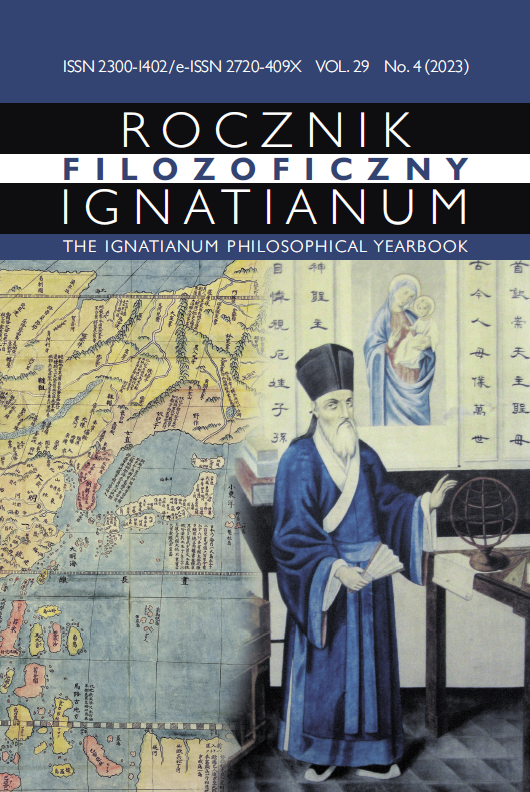Symbols in the Urban Space of Częstochowa as a Message of Art, Values and Tradition
Abstract
Częstochowa is a city located in the Silesian Voivodeship, its origin dates back to the eleventh century. It received the town rights in 1356. It is the largest religious cult centre in Poland, which in 2022 attracted 2.5 million people from all over the world. The Pilgrims’ goal was Jasna Góra. It is an academic city, a developing centre of culture and art. The article is devoted to both historical and contemporary objects of Częstochowa, which the most important value is their symbolic dimension. The author presented religious, architectural and artistic objects that commemorate important figures in the history of the city related to literature, theatre, painting, sculpture and social activities for the benefit of residents. The subject of the research is the analysis in terms of transformations of contemporary meanings and symbols, the space of one of the most famous urban arteries, which is the Avenue of the Blessed Virgin Mary. The subject of the research concerns the analysis of examples of artistic objects located in the main artery of the city and the adjacent Old Market Square located in the district called the Old Town, which is used by not only the residents and tourists, but also the crowds of domestic and foreign pilgrims heading to the Jasna Góra sanctuary. Art has also found its place in this urban space, which was considered a good background and stage for artistic activities in the form of e.g. sculptures, monuments and murals commemorating the work of artists, thus creating a space for reflection, emotions and memories. The article ends with the considerations whether in modern times it is possible to combine the desire to create modern public space with the maintaining historical continuity and undeniable urban values.
References
Białostocki Jan, Sztuka cenniejsza niż złoto, t. II (Warszawa: PWN, 1974). Biegańska Mieczysława, Biegański Władysław, Władysław Biegański: życie i praca (Warszawa: Wydawnictwo Kasy im. Mianowskiego, Instytut Popierania Nauki, 1930).
Braun Juliusz, Częstochowa urbanistyka i architektura (Warszawa: Wydawnictwo Arkady, 1977).
Franta Anna, Reżyseria przestrzeni. O doskonaleniu przestrzeni publicznej miasta (Kraków: Politechnika Krakowska, 2004).
Jackowski Antoni, Święta przestrzeń świata (Kraków: Wydawnictwo Uniwersytetu Jagiellońskiego, 2003).
Kosiński Wojciech, Miasto i piękno miasta (Kraków: Wydawnictwo Politechniki Krakowskiej, 2011).
Lorens Piotr, Tematyzacja przestrzeni publicznej miasta (Gdańsk: Wydawnictwo Politechniki Gdańskiej, 2008).
Lynch Kevin, Obraz miasta (Kraków: Wydawnictwo Archivolta, 2011). Nadworski Henryk, Sacrum przestrzeni kościelnych (Kielce: Wydawnictwo Jedność, 2005).
Pawlikowska-Piechotka Anna, Wartości kultura a zrównoważony rozwój miasta (Warszawa: Instytut Gospodarki Przestrzennej i Komunalnej, 1998).
Piasecka Małgorzata, Sętkowski Juliusz, Sienkiewicz. IV LO im. H. Sienkiewicza w Częstochowie 1862–2012 (Częstochowa: Muzeum Częstochowskie, 2012). Rozanow Zofia, Smulikowska Ewa (oprac.), Częstochowa. Część 1. Stare i Nowe Miasto Katalog Zabytków Sztuki (Warszawa: Wydawnictwo Instytut Sztuki PAN, 1995).
Suleja Włodzimierz, Józef Piłsudski (Wrocław–Warszawa–Kraków: Zakład Narodowy im. Ossolińskich, 1995).
Snoch Bogdan, Mała encyklopedia Częstochowy (Częstochowa: Wydawca Towarzystwo Przyjaciół Częstochowy, 2002).
Wallis Aleksander, Socjologia przestrzeni, wyb. i oprac. Elżbieta Grabska-Wallis, Maria Ofierska; posłowie Janusz Ziółkowski (Warszawa: Niezależna Oficyna Wydawnicza, 1990).
Malinowska-Petelenz Beata, „Między tradycją a nowoczesnością, czyli współczesne sacrum w przestrzeni miejskiej”, Czasopismo Techniczne. Architektura 102 (2005) 9-A.
Tubielewicz-Michalczuk Malwina, „Selected Educational Buildings and Their Role in Contemporary Education, on the Example of Częstochowa”, Przestrzeń i Forma 53 (2023): 91–108.
Tubielewicz-Michalczuk Malwina, “The Public Spaces of Częstochowa in the 21st Century”, w: Architecture in Perspective 13, eds. Perinkova Martina, Juttnerova Sandra, Videcka Lucie (Ostrava: Technical University of Ostrava, 2019), 111–113.
Copyright (c) 2023 Ignatianum University in Cracow

This work is licensed under a Creative Commons Attribution 4.0 International License.
The Yearbook only accepts materials for publication that are free of all conflicts of interest, and that in no way involve conflicts over authorship, copyright, etc. The Editors will take action against any cases of plagiarizing, ghostwriting1, guest/honorary authorship2, etc. Where co-authored work is concerned, the Author listed first is expected to take responsibility for the submission, and is required to make clear the contributions of all of the Co-Authors involved. In the event of the publication owing its existence to funding dedicated to this purpose, this fact should be made clear: e.g. in any note of thanks/acknowledgement, or in a footnote, etc. Explicit notification should be given of any form of reprinting, with the appropriate evidence of permission to publish being furnished as required. Any impropriety on the part of Authors/Reviewers risks exposing them to appropriate responses from the relevant institutions.
______
1 This term refers to instances of a person who has made an essential contribution being omitted from the list of authors, or from notes conveying gratitude and/or acknowledgement.
2 This occurs when a person who has made either an insignificant contribution or no contribution at all nevertheless appears on the list of authors.





